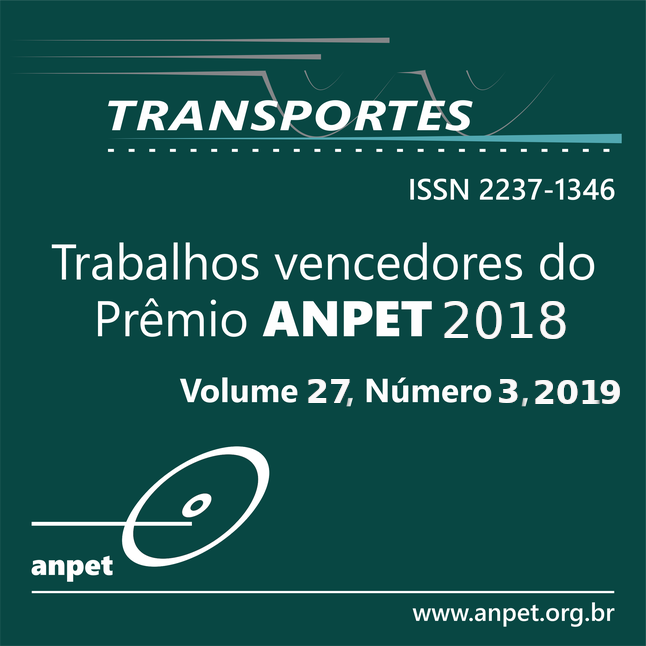Ambiente construído e bem-estar subjetivo: análise das diferenças entre os usuários dos diferentes modos de transporte
DOI:
https://doi.org/10.14295/transportes.v27i3.2021Keywords:
Walkability, Structural equation modelling, Security, Neighborhood perception, Neighborhood satisfaction.Abstract
Subjective well-being has been focus of increased attention in the research community during the last decades and specifically in the transportation field (economy, urban environment, mobility and accessibility). The purposes of this study are to analyze the existence of differentiated perceptions of the built environment among users of active travel, public and private transportation; and comparing the effect of built environment on well-being for the three groups of users. Using data from a physical activity survey of São Paulo - Brazil, multi-group structural equation models were estimated. The study showed that the built environment influences the individual’s well-being for the three groups of users. It evidenced the existence of differences in built environment perceptions between the groups. The results could contribute to academic and policy debates on well-being, quality of life and urban sustainability considering a lack of empirical research on this topic.Downloads
References
Basarić V.; A. Vujičić; J. M. Simić; V. Bogdanović e N. Saulić (2016) Gender and Age Differences in the Travel Behavior – A Novi Sad Case Study. Transportation Research Procedia, v. 14, p. 4324-4333. DOI: 10.1016/j.trpro.2016.05.354.
Brown, G. T.; L. R. Harris; C. O'Quin e K. E. Lane (2015) Using multi-group confirmatory factor analysis to evaluate cross-cultural research: identifying and understanding non-invariance. International Journal of Research & Method in Education. v. 40, n. 1, p. 66-90. DOI: 10.1080/1743727X.2015.1070823.
Cabrera, J. F. (2013). New urbanism and selection bias in the formation of social capital. Housing Policy Debate, v. 23, n. 2, p. 376–394. DOI: 10.1080/10511482.2013.766626.
Cheung, G.W. e R. B. Rensvold (2002) Evaluating goodness-of-fit indexes for testing measurement invariance. Structural equation modeling, v. 9, n. 2, p. 233-255. DOI: 10.1207/S15328007SEM0902_5.
Delbosc, A. (2012) The role of well-being in transport policy. Transp. Policy, v. 23, p. 25–33. DOI: 10.1016/j.tranpol.2012.06.005.
Diamantopoulos, A.; P. Riefler e K. P. Roth (2008) Advancing formative measurement models. Journal of Business Research, v. 61, n. 12, p. 1203-1218. DOI: 10.1016/j.jbusres.2008.01.009.
Diener, E. (1984) Subjective Well-Being. Psychological Bulletin, v. 95, p. 542-575. DOI:10.1037/0033-2909.95.3.542.
Diener, E. (1994) Assessing subjective wellbeing: progress and opportunities. Social Indicators Research, v. 31, p. 103-157. DOI: 10.1007/BF01207052.
Dong, H. e Qin, B. (2017) Exploring the link between neighborhood environment and mental wellbeing: A case study in Beijing, China. Landscape and Urban Planning, v. 164, p. 71-80. DOI: 10.1016/j.landurbplan.2017.04.005.
Elias, W.; J. Benjamin e Y. Shiftan (2015) Gender differences in activity and travel behavior in the Arab world. Transport Policy, v. 44, p. 19-27. ISSN 0967-070X. DOI: 10.1016/j.tranpol.2015.07.001.
Gehl, J. (2013) Cities for people. Island press. ISBN 9781597265737
González, R. M.; E. Martínez-Budría; J. J. Díaz-Hernández e A. Esquivel (2015) Explanatory factors of distorted perceptions of travel time in tram. Transportation Research Part F: Traffic Psychology and Behaviour, v. 30, p. 107-114. ISSN 1369-8478. DOI: 10.1016/j.trf.2015.02.006.
Grasser, G.; S. Titze e W. J. Stronegger (2016) Are residents of high-walkable areas satisfied with their neighbourhood? Journal of Public Health, v. 24, n. 6, p. 469-476. DOI: 10.1007/s10389-016-0744-5.
Hair, J. F.; W. C. Black; B. J. Babin; R. E. Anderson e R. L. Tatham (2009) Análise Multivariada de Dados. 6 ed. Bookman. Porto Alegre. ISBN 857780402X
Heizomi, H.; H. Allahverdipour; M. A. Jafarabadi e A. Safaian (2015) Happiness and its relation to psychological well-being of adolescents. Asian Journal of Psychiatry, v. 16, p. 55-60. DOI:10.1016/j.ajp.2015.05.03.
Her, Y. W.; H. Shin e S. Pae (2018) A multigroup SEM analysis of moderating role of task uncertainty on budgetary participation-performance relationship: Evidence from Korea. Asia Pacific Management Review. DOI: 10.1016/j.apmrv.2018.02.001.
Hipp, J. R. e A. J. Perrin (2009) The simultaneous effect of social distance and physical distance on the formation of neighborhood ties. City & Community, v. 8, n. 1, p. 5-25. DOI: 10.1111/j.1540-6040.2009.01267.x.
Hu, L. (2017) Changing travel behavior of Asian immigrants in the U.S. Transportation Research Part A: Policy and Practice, v. 106, p. 248-260. ISSN 0965-8564. DOI: 10.1016/j.tra.2017.09.019.
Jacobs J. (2011) Morte e vida de grandes cidades. 2. ed. [s.l.] WMF Martins Fontes. ISBN 9788578274214
Joshanloo, M. (2017) Mediators of the relationship between externality of happiness and subjective well-being. Personality and Individual Differences, v. 119, p. 147-151. DOI: 10.1016/j.paid.2017.07.017.
Kim, H. e R. Millsap (2014) Using the Bollen-Stine Bootstrapping Method for Evaluating Approximate Fit Indices. NIH Public Access, v. 49, n. 6, p. 161–169. DOI: 10.1080/00273171.2014.947352.
Kim, S.; S. Park e J. S. Lee (2014) Meso-or micro-scale? Environmental factors influencing pedestrian satisfaction. Transportation Research Part D: Transport and Environment, v. 30, p. 10-20, 2014. DOI: 10.1016/j.trd.2014.05.005.
Larranaga, A. M. e H. B. B. Cybis (2014) The relationship between built environment and walking for different trip purposes in Porto Alegre, Brazil. Int Journal of Sustainable Development and Planning, v. 9, n. 4, p. 568-580. DOI: 10.2495/SDP-V9-N4-568-580.
Larranaga, A. M.; J. L. D. Ribeiro e H. B. B. Cybis (2009) Fatores que afetam as decisões individuais de realizar viagens a pé: estudo qualitativo. Transportes, v. 17, n. 2. DOI: 10.14295/transportes.v17i2.355.
Larranaga, A. M.; L. I. Rizzi; J. Arellana; O. Strambi e H. B. B. Cybis (2014) The Influence of built environment and travel attitudes on walking: a case study of Porto Alegre, Brazil. International Journal of Sustainable Transportation, v. 10, n. 4, p. 332-342. DOI: 10.1080/15568318.2014.933986.
Lee, S. M.; T. L. Conway; L. D. Frank; B. E. Saelens; K. L. Cain e J. F. Sallis (2017) The relation of perceived and objective environment attributes to neighborhood satisfaction. Environm and Behaviour, v. 49, n. 2, p. 136-160. DOI: https://doi.org/10.1016/j.tbs.2018.02.005.
Leslie, E. e E. Cerin (2008) Are perceptions of the local environment related to neighbourhood satisfaction and mental health in adults?. Preventive Medicine, v. 47, n. 3, p. 273-278. DOI: 10.1016/j.ypmed.2008.01.014.
Leyden, K. M. (2003) Social capital and the built environment: the importance of walkable neighborhoods. American Journal of Public Health, v. 93, n. 9, p. 1546-1551. DOI: 10.2105/AJPH.93.9.1546.
Limbers, C. A.; D. A. Newman e J. W. Varni (2009) Factorial Invariance of Child Self-Report Across Race/Ethnicity Groups: A Multigroup Confirmatory Factor Analysis Approach Utilizing the PedsQL™ 4.0 Generic Core Scales. Annals of Epidemiology, v. 19, n. 8, p. 575-581. DOI: 10.1016/j.annepidem.2009.04.004.
Lin, T.; D. Wang e X. Guan (2017) The built environment, travel attitude, and travel behavior: Residential self-selection or residential determination?. Journal of Transport Geography, v. 65, p. 111-122. ISSN 0966-6923. DOI: 10.1016/j.jtrangeo.2017.10.004.
Lucchesi, S. T; A. M. Larranaga e H. B. B. Cybis (2018) Does Walkability Raise Real Estate Values in Brazil? A Hedonic Model Approach on Rio de Janeiro City. Transportation Research Board 97th Annual Meeting. 2018 Jan 7-11; Washington DC, United States.
Lucchesi, S. T. (2016) Aplicação de preços hedônicos para avaliação da influência da caminhabilidade no preço dos imóveis. Dissertação de Mestrado – PPGEP, UFRGS. Disponível em http://hdl.handle.net/10183/150501. (Acesso em 5 agosto 2019).
Mccrea, R.; R. Stimson e J. Western (2005) Testing a moderated model of satisfaction with urban living using data for Brisbane-South East Queensland, Australia. Social Indicators Research, v. 72, n. 2, p. 121-152. DOI: 10.1007/s11205-004-2211-x.
Mouratidis, K. (2018) Built environment and social well-being: How does urban form affect social life and personal relationships?. Cities, v. 74, p. 7-20. DOI: 10.1016/j.cities.2017.10.020.
Musa, H. D.; M. R. Yacob; A. M. Abdullah e M. Y. Ishak (2018) Enhancing subjective well-being through strategic urban planning: Development and application of community happiness index. Sustainable Cities and Society, v. 38, p. 184-194. DOI: 10.1016/j.scs.2017.12.030.
Reardon, L. e Abdallah, S. (2013) Well-being and transport: taking stock and looking forward. Transport Rev, v. 33, n. 6, p. 634–657. DOI: 10.1080/01441647.2013.837117.
Samios, A. A. B. (2018) Impacto do ambiente construído na utilização de modos ativos: análise das percepções dos usuários de diferentes modos de transporte. Dissertação de Mestrado – PPGEP, UFRGS. Disponível em: http://hdl.handle.net/10183/179524. (Acesso em 3 setembro 2019).
Schumacker, R. E. e R. G. Lomax (2010) A beginner's guide to structural equation modeling. Psychology press.
Singleton, P. A. (2018) Walking (and cycling) to well-being: Modal and other determinants of subjective well-being during the commute. Travel Behaviour and Society (in press). DOI:10.1016/j.tbs.2018.02.005.
Sirgy, M. J. e T. Cornwell (2002). How neighborhood features affect quality of life. Social Indicators Research, v. 59, n. 1, p. 79-114. DOI: 10.1023/A:1016021108513.
Spinney, J. E. L.; D. M. Scott e K. B. Newbold (2009) Transport mobility benefits and quality of life: a time-use perspective of elderly Canadians. Transport Policy, v. 16, n. 1, p. 1–11. DOI:10.1016/j.tranpol.2009.01.002.
Stanley, J. e J. Stanley (2007) Public transport and social policy goals. Road and Transport Res, v. 16, p. 20-30. ISSN 1037-5783
Stanley, J. e D. Vella-Brodrick (2009) The usefulness of social exclusion to inform social policy in transport. Transport Policy, v. 16, p. 106-114. DOI: 10.1016/j.tranpol.2009.02.003.
Stanley, J.; D. A. Henscher; J. Stanley; G. Currie; W.H. Greene e D. Vella-Brodrick (2011) Social exclusion and the value of mobility. Journal of Transport Economics and Policy, v. 45, p. 197-222.
Van Dyck, D.; G. Cardon; B. Deforche e I. D. Bourdeaudhuij (2011) Do adults like living in high-walkable neighborhoods? Associations of walkability parameters with neighborhood satisfaction and possible mediators. Health & Place, v. 17, n. 4, p. 971-977. DOI: 10.1016/j.healthplace.2011.04.001.
Vargas, J. C. B.; A. M. L. Uriarte e H.B.B. Cybis (2016) Explorando as viagens a pé: estrutura urbana e sensação de segurança. Anais do XXX Congresso de Pesquisa e Ensino em Transportes, ANPET.
Wang, D. e X. Cao (2017) Impacts of the built environment on activity-travel behavior: Are there differences between public and private housing residents in Hong Kong? Transportation Research Part A: Policy and Practice, v. 103, p. 25-35. DOI:10.1016/j.tra.2017.05.018.
Wood, L.; L. D. Frank e B. Giles-Corti (2010) Sense of community and its relationship with walking and neighborhood design. Social Science & Medicine, v. 70, n.9, p. 1381–1390. DOI:10.1016/j.socscimed.2010.01.021.
Yang, S.; Y. Fan; W. Deng e L. Cheng (2017) Do built environment effects on travel behavior differ between household members? A case study of Nanjing, China. Transport Policy. ISSN 0967-070X. DOI: 10.1016/j.tranpol.2017.12.006.
Ziersch, A. M.; F. E. Baum; C. MacDougall e C. Putland (2005) Neighbourhood life and social capital: The implications for health. Social Science & Medicine, v. 60, n. 1, p. 71–86. DOI: 10.1016/j.socscimed.2004.04.027.
Downloads
Published
How to Cite
Issue
Section
License
Authors who submit papers for publication by TRANSPORTES agree to the following terms:
- The authors retain the copyright and grant Transportes the right of first publication of the manuscript, without any financial charge, and waive any other remuneration for its publication by ANPET.
- Upon publication by Transportes, the manuscript is automatically licensed under the Creative Commons License CC BY 4.0 license. This license permits the work to be shared with proper attribution to the authors and its original publication in this journal, and to be adapted for non-commercial purposes, provided appropriate credit is given and any derivative works are distributed under the same terms.
- Authors are authorized to enter into additional separate contracts for the non-exclusive distribution of the version of the manuscript published in this journal (e.g., publishing in an institutional repository or as a book chapter), with recognition of the initial publication in this journal, provided that such a contract does not imply an endorsement of the content of the manuscript or the new medium by ANPET.
- Authors are permitted and encouraged to publish and distribute their work online (e.g., in institutional repositories or on their personal websites) after the editorial process is complete. As Transportes provides open access to all published issues, authors are encouraged to use links to the DOI of their article in these cases.
- Authors guarantee that they have obtained the necessary authorization from their employers for the transfer of rights under this agreement, if these employers hold any copyright over the manuscript. Additionally, authors assume all responsibility for any copyright infringements by these employers, releasing ANPET and Transportes from any responsibility in this regard.
- Authors assume full responsibility for the content of the manuscript, including the necessary and appropriate authorizations for the disclosure of collected data and obtained results, releasing ANPET and Transportes from any responsibility in this regard.









